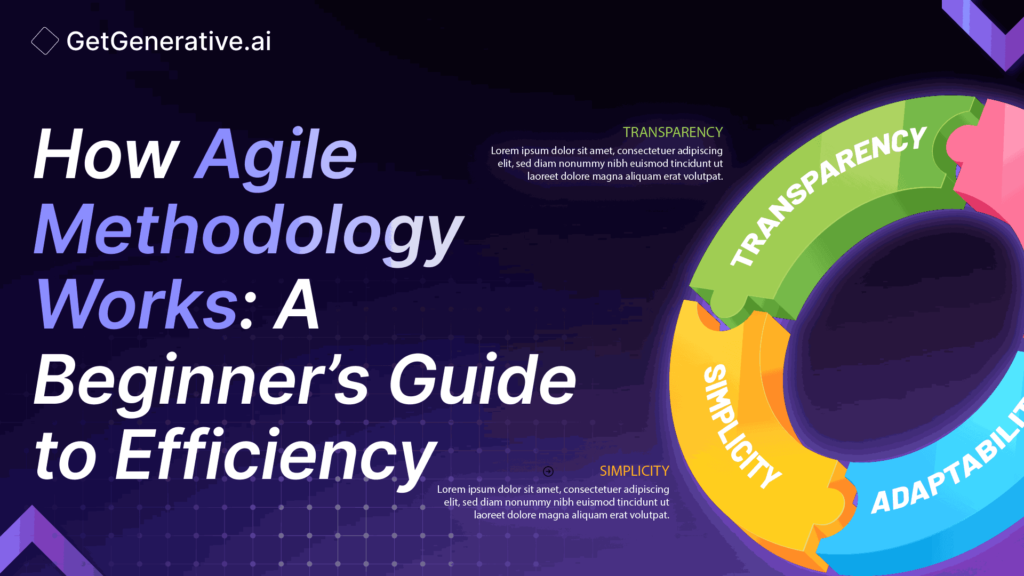How Agile Methodology Works: A Beginner’s Guide to Efficiency
Agile methodology is more than a simple term in project management—it’s an adaptive approach aimed at handling projects by promoting flexibility, teamwork, and quicker value delivery. But how does Agile really operate, and why has it gained such widespread appeal?
Let’s break it down step by step, so you can see why teams around the world are adopting this approach to make their projects run more smoothly.
Introduction to Agile Methodology
Agile methodology enables teams to execute projects with an iterative and adaptable process. In contrast to conventional project management models, Agile focuses on continuous collaboration, integrating customer feedback, and releasing small, functional increments regularly. By working in short cycles called sprints, Agile teams can adapt to changes quickly and continuously improve their work.
The Core Principles of Agile
Central to Agile are the 12 principles laid out in the Agile Manifesto. Created by software developers in 2001, this document serves as a blueprint for teams looking to implement Agile methods. These principles highlight the significance of people and their interactions, functioning software, collaboration with customers, and the ability to respond to change.
Agile Methodology Steps
Agile methodology follows six distinct phases that guide teams through the lifecycle of a project:
1. Concept
The first stage of the Agile process is to evaluate and prioritize potential projects. This stage includes engaging with team members and stakeholders to brainstorm, explore business opportunities, and assess the time and cost for each project. Once you’ve identified viable projects, you can prioritize them based on feasibility and value, creating a project backlog that aligns with business goals.
2. Inception
After deciding on the project, the next step is figuring out how to bring it to life. You’ll need to form your team and define the project’s initial requirements. A visual diagram can help outline team responsibilities and break down the work into manageable tasks for each sprint, setting the stage for efficient execution.
3. Iteration
With a clear project plan in place, the development team can begin working on the first iteration. This phase involves several key activities:
- Requirements: Confirm project requirements based on the backlog and feedback from stakeholders.
- Development: Build the product in accordance with established requirements.
- Testing: Conduct quality assurance (QA) tests to validate features and identify any issues.
- Delivery: Provide a functional product for review.
- Feedback: Collect feedback from customers and stakeholders to refine the requirements for the next iteration.
Also Read – What Is Agile Methodology in Project Management?
4. Release
Once multiple iterations have been completed, it’s time to finalize the product. During the release phase, you’ll carry out final testing and QA processes, address any remaining defects, and prepare user documentation before deploying the product into production.
5. Production
During the production phase, the product is live and available to users. Your team’s focus shifts to providing ongoing support and monitoring to ensure smooth operation and to assist users in navigating the new system.
6. Retirement
When a product becomes obsolete, unnecessary, or ready to be replaced, it enters the retirement phase. This stage involves activities such as notifying users and decommissioning the product from production, often migrating users to a new system.
Examples of Agile Methodologies
Agile methodology is a broad philosophy that can be adapted to several development models. Here are some of the most widely used Agile methodologies:
1. Scrum
Scrum is a widely-used Agile framework that focuses on fostering cross-functional teamwork, promoting accountability, and utilizing iterative processes to build complex products. While primarily used in software development, Scrum can be applied across various project management scenarios.
Scrum organizes the workflow into specific roles, events, and artifacts:
- Scrum Roles: The primary roles in Scrum consist of the Product Owner, the Scrum Master, and the Development Team.
- Scrum Events: Teams participate in key activities such as the Daily Stand-up (Scrum), Sprint Planning, Sprint Review, and Sprint Retrospective.
- Scrum Artifacts: Essential artifacts in Scrum are the Product Backlog, Sprint Backlog, and the Increment, which represents the Sprint Objective or Goal.
Scrum teams often use visual tools like task boards to manage and visualize the progress of tasks and sprints.
2. Kanban
Kanban is built on three core principles:
- Visualizing the workflow
- Limiting work in progress (WIP)
- Prioritizing tasks based on importance
Unlike Scrum, Kanban doesn’t use predefined roles or timeboxed sprints. Instead, it promotes continuous delivery and provides team members with a clear visual representation of their responsibilities via tools like Kanban boards, which track task statuses and progress. This helps ensure that teams focus on high-priority tasks and maintain steady progress.
Related Read – Types of Agile Methodologies: Principles and Applications
3. Extreme Programming (XP)
XP is a highly detailed Agile framework designed specifically for software development. XP prioritizes communication, feedback, simplicity, courage, and respect among team members.
XP is ideal when:
- Project requirements are constantly evolving.
- Teams face tight deadlines.
- Stakeholders want to minimize risks under time constraints.
- Automated unit and functional tests are necessary to ensure quality.
4. Feature-Driven Development (FDD)
Feature-Driven Development is a client-centered Agile approach focused on incremental progress and consistent status updates. This framework reduces common challenges, such as confusion and unnecessary rework, during the development process.
FDD consists of five steps:
- Develop an overall model.
- Build a feature list.
- Plan by feature.
- Design by feature.
- Build by feature.
FDD is scalable and delivers features within a short timeframe, often between 2 to 10 days, making it easier for teams to adapt to client needs, address issues, and onboard new team members quickly.
Conclusion
Agile methodology provides a flexible, iterative project management approach that enables teams to quickly adapt to changes, accelerate value delivery, and improve collaboration. Whether using Scrum, Kanban, XP, or FDD, it’s important to choose a framework that best fits your team’s specific needs.
To learn more, visit GetGenerative.ai today!
FAQs
1. How long is a typical Agile sprint?
A typical Agile sprint lasts between two to four weeks, depending on the team’s goals and the complexity of the work.
2. What industries use Agile methodology?
While Agile originated in software development, it’s now widely used in industries like marketing, finance, manufacturing, and even healthcare.
3. Can Agile be scaled for larger teams?
Yes, frameworks like SAFe (Scaled Agile Framework) are specifically designed to scale Agile across large organizations and teams.




